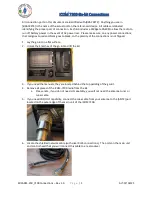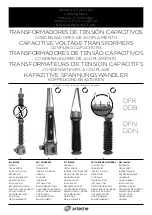
3
– Menus
27
Menu
Description
ON
Turn the main sensor on or off.
PRINCIPAL
■
Display
: display the reading from the main sensor.
■
Primary
: display the reading from the main sensor and go to the
4-20 mA menu (see step below).
■
Secondary
: the reading is not displayed.
Note: if multiple sensors (main sensor, ANA1 sensor or ANA2
sensor) are configured as the
Primary
, the -4-20 mA output will use
the current corresponding to the
Main sensor
.
4-20 mA
Define the output current type (see the
Note on the 4-20 mA current
type
on page 27).
■
Normal
: standard 4-20 mA signal.
■
Combined
: signal uses predefined values representing the alarm
statuses of the 3 sensors. This option is automatically selected if
the
Secondary
option was defined in the previous step.
■
CAPEX
: all-or-nothing signal indicating normal operation or a fault
condition.
Coef none
Defines the reading integration time (none, 5 seconds, 30 seconds,
1 minute, 2, 5, 10 or 15 minutes). The reading will be averaged over
the given period.
Ovr Lock
■
Yes
: verification is activated. If the device detects a gas
concentration above 100% LEL, it will display the word "
Sup
." The
reading is blocked and the output signal is fixed at 23.2 mA. The
verification request is acknowledged using the infrared remote
control. See the section on
Verification
on page 71.
■
No
: verification is not activated.
Sure ??
■
ENTER
: confirm the changes made.
■
ESC
: cancel the changes made and return to the
PROG
menu.
Note on the 4-20 mA current type
Normal mode
0 mA signal:
no power.
1 mA signal:
fault code.
2 mA signal:
in calibration.
Signal from 4-20 mA: reading from the main channel (
Menu > PROG
).
Signal greater than 20 mA: line fault, out-of-range, verification.
Combined mode
1 mA : 1 faulty sensor.
2 mA : in stabilization or calibration.
4 mA : no fault and no alarm
8 mA : 1 sensor out of 3 in alarm #1
12 mA : 2 sensors out of 3 in alarm #1
16 mA : 3 sensors in alarm #1.
19 mA : 1 sensor out of 3 in alarm #2
22 mA : 1 sensor out-of-range or to be verified.
Note: an alarm always takes priority over a fault, unless the alarm is
generated by the faulty channel.
CAPEX function
Comprises 2 statuses:
Good
or
Bad
.
0.1 mA : in fault, alarm, calibration or stabilization.
20 mA : no fault and no alarm
Summary of Contents for olct 80
Page 1: ...1 User manual OLCT 80 Part Number NPO80GB Revision E 1 The Fixed Gas Detection Experts...
Page 6: ...Table of Contents vi...
Page 10: ...1 Overwiew 4...
Page 18: ...2 Transmitter Overview 12...
Page 22: ...3 Menus 16 Figure 15 the OLCT 80 s sub menus under AFF MES DATE TIME and PROG...
Page 23: ...3 Menus 17 Figure 16 the OLCT 80 s sub menus under MAINT CALIBRA 4 20mA INFOS and TEST...
Page 42: ...3 Menus 36 Figure 26 RELAY 1 menu Press ESC repeatedly to return to the reading display...
Page 58: ...3 Menus 52...
Page 74: ...5 Wireless Version 68...
Page 82: ...7 Pre installation Hardware Configuration 76...
Page 84: ...8 Preventative Maintenance 78...
Page 90: ...10 Accessories 84...
Page 96: ...12 EU Declarations of Conformity 90 OLCT 80 without antenna...
Page 97: ...12 EU Declarations of Conformity 91...
Page 98: ...12 EU Declarations of Conformity 92 OLCT 80 with antenna...
Page 99: ...12 EU Declarations of Conformity 93...
Page 100: ...12 EU Declarations of Conformity 94 IR20 remote control of the OLCT 80...
Page 108: ...13 Technical Specifications 102...
Page 116: ...14 Special instructions for use in explosive environments and fonctional safety 110...
Page 119: ...113...
















































